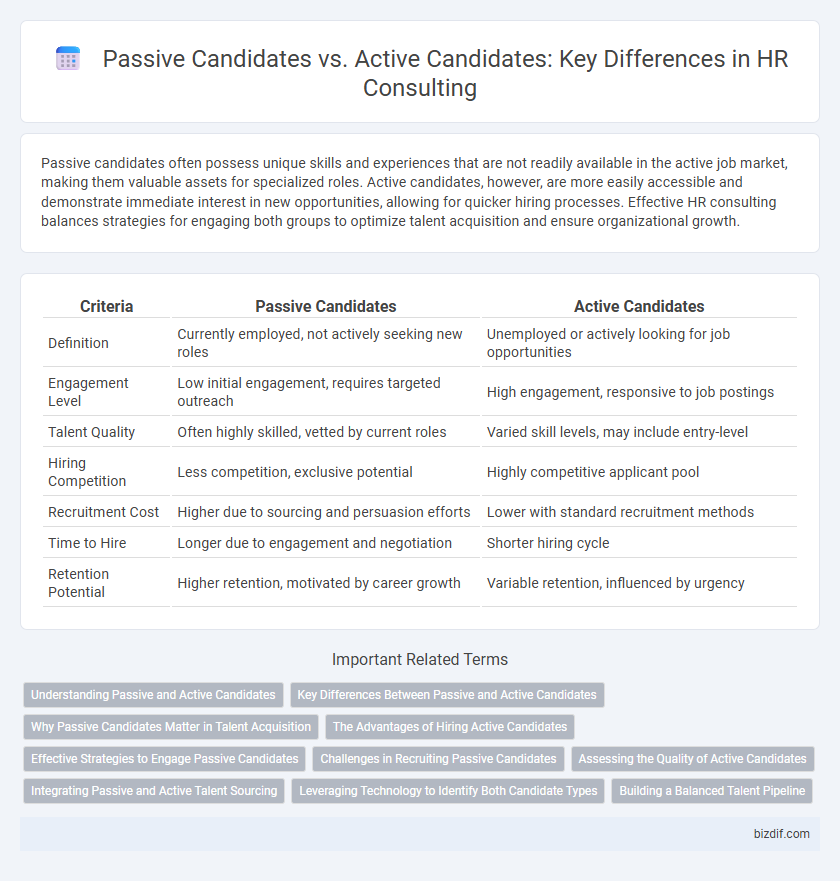Passive candidates often possess unique skills and experiences that are not readily available in the active job market, making them valuable assets for specialized roles. Active candidates, however, are more easily accessible and demonstrate immediate interest in new opportunities, allowing for quicker hiring processes. Effective HR consulting balances strategies for engaging both groups to optimize talent acquisition and ensure organizational growth.
Table of Comparison
| Criteria | Passive Candidates | Active Candidates |
|---|---|---|
| Definition | Currently employed, not actively seeking new roles | Unemployed or actively looking for job opportunities |
| Engagement Level | Low initial engagement, requires targeted outreach | High engagement, responsive to job postings |
| Talent Quality | Often highly skilled, vetted by current roles | Varied skill levels, may include entry-level |
| Hiring Competition | Less competition, exclusive potential | Highly competitive applicant pool |
| Recruitment Cost | Higher due to sourcing and persuasion efforts | Lower with standard recruitment methods |
| Time to Hire | Longer due to engagement and negotiation | Shorter hiring cycle |
| Retention Potential | Higher retention, motivated by career growth | Variable retention, influenced by urgency |
Understanding Passive and Active Candidates
Passive candidates are professionals not actively seeking new job opportunities but remain open to compelling offers, often possessing specialized skills and higher retention rates. Active candidates, conversely, are actively applying for jobs and engaged in the hiring process, typically motivated by immediate employment needs or career changes. Effective HR consulting requires tailored strategies to engage both groups, leveraging passive candidates' untapped potential while efficiently managing active candidates to fill roles quickly.
Key Differences Between Passive and Active Candidates
Passive candidates are individuals currently employed and not actively seeking new job opportunities, often requiring targeted recruitment strategies to engage their interest. Active candidates are those openly searching for jobs, readily applying to postings and responding to outreach efforts. Understanding these key differences helps HR consultants tailor sourcing approaches, optimize talent acquisition, and improve hiring outcomes by addressing the unique motivations and behaviors of each candidate group.
Why Passive Candidates Matter in Talent Acquisition
Passive candidates often possess unique skills and experiences that active candidates may lack, making them valuable assets in competitive talent acquisition markets. They are typically employed, demonstrating proven performance and stability, which can translate to lower turnover rates. Engaging passive candidates requires strategic outreach but yields access to a broader, high-quality talent pool that drives organizational growth.
The Advantages of Hiring Active Candidates
Hiring active candidates offers the advantage of immediate availability, enabling faster onboarding and reduced time-to-fill for critical roles. These candidates often provide a clearer picture of their current skills and job expectations, facilitating a more accurate fit with organizational needs. Companies benefit from active candidates' stronger motivation for career change, leading to higher engagement and quicker contributions to business goals.
Effective Strategies to Engage Passive Candidates
Engaging passive candidates requires personalized communication that highlights unique opportunities aligning with their career goals and values. Leveraging social media platforms, employee referrals, and targeted content marketing helps build long-term relationships with top talent who are not actively job searching. Offering insights into company culture, growth potential, and exclusive benefits increases interest and motivates passive candidates to consider new roles.
Challenges in Recruiting Passive Candidates
Recruiting passive candidates presents challenges such as limited accessibility and lower responsiveness compared to active candidates who are already seeking new opportunities. HR consultants must employ targeted strategies like personalized outreach and relationship-building to effectively engage passive talent. Additionally, assessing passive candidates often requires deeper market insights and a tailored approach to demonstrate value and potential career growth.
Assessing the Quality of Active Candidates
Assessing the quality of active candidates involves evaluating their current skills, relevant experience, and cultural fit through targeted interviews and validated assessment tools. Active candidates typically demonstrate immediate availability and a clear motivation to engage, which provides a more predictable timeline for recruitment. Leveraging psychometric testing and structured interviews enhances the accuracy of selecting high-potential active candidates, ultimately improving hiring success rates.
Integrating Passive and Active Talent Sourcing
Integrating passive and active talent sourcing enhances HR consulting strategies by expanding access to a diverse candidate pool, combining proactive outreach with traditional recruitment methods. Leveraging advanced analytics and AI-driven tools enables precise identification and engagement of passive candidates while efficiently managing active applicants. Effective integration improves talent acquisition outcomes, reduces time-to-hire, and aligns candidate capabilities with organizational needs.
Leveraging Technology to Identify Both Candidate Types
Leveraging technology in HR consulting enhances the identification of both passive and active candidates by utilizing AI-driven platforms to analyze online behavior, professional networks, and engagement patterns. Advanced applicant tracking systems (ATS) and candidate relationship management (CRM) tools enable recruiters to nurture passive candidates through personalized communication while streamlining the hiring process for active job seekers. Integrating data analytics and machine learning algorithms increases the accuracy of candidate sourcing, improving talent acquisition efficiency across diverse job markets.
Building a Balanced Talent Pipeline
Building a balanced talent pipeline requires strategic engagement with both passive and active candidates, leveraging targeted outreach and employer branding to attract high-quality talent. Passive candidates, often not actively seeking new roles, can bring unique skills and deeper industry experience, while active candidates offer immediacy and readiness to fill vacancies. Combining data-driven sourcing techniques and personalized communication enhances recruitment outcomes and ensures a sustainable talent supply.
Passive Candidates vs Active Candidates Infographic

 bizdif.com
bizdif.com